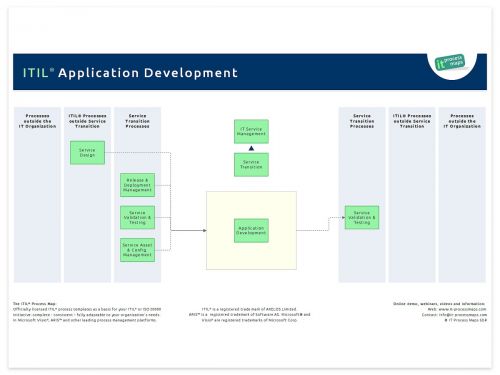Application Development and Customization: Difference between revisions
No edit summary |
No edit summary |
||
| Line 13: | Line 13: | ||
<meta property="og:image:width" content="1200" /> | <meta property="og:image:width" content="1200" /> | ||
<meta property="og:image:height" content="900" /> | <meta property="og:image:height" content="900" /> | ||
<link href="https://plus.google.com/108613479011811316823/posts" rel="publisher" /> | <link href="https://plus.google.com/108613479011811316823/posts" rel="publisher" /> | ||
</itpmch> | </itpmch> | ||
Latest revision as of 11:55, 31 December 2023

Objective: ITIL Application Development aims to make available applications and systems which provide the required functionality for IT services. This ITIL process includes the development and maintenance of custom applications as well as the customization of products from software vendors.
Part of: Service Transition
Process Owner: Application Developer
Process Description
Application Development is barely mentioned in the ITIL books, as ITIL focuses on different topics like service design and rollout. At IT Process Maps we decided to bridge that gap by introducing an Application Management process which takes care of application coding and the customization of software packages.

Even if ITIL Application Management is generally regarded a field of its own, we think an Application Management process should be included in any ITIL process structure to make sure there are clearly defined interfaces between the design, development and rollout stages of a service. The process overview of ITIL Application Development (.JPG) shows the key information flows (see fig. 1).
Note: ITIL 2011 does not provide a detailed explanation of all aspects of Application Development. Rather, it highlights the key activities and assists in identifying the interfaces with other Service Management processes.
The latest edition of ITIL 4 describes the key activities of ITIL application development in the technical management practice of "Software Development and Management".
Sub-Processes
No sub-processes are specified for ITIL Application Development.
Definitions
The following ITIL terms and acronyms (information objects) are used in ITIL Application Development to represent process outputs and inputs:
User Manual
- A document for end-users, describing how to use an application or system.
Technical/ Administration Manual
- A document describing the procedures required to run and maintain a type of application or infrastructure component.
Roles | Responsibilities
Application Developer - Process Owner
- The Application Developer is responsible for making available applications and systems which provide the required functionality for IT services. This includes the development and maintenance of custom applications as well as the customization of products from software vendors.
| ITIL Role / Sub-Process | Application Developer |
|---|---|
| Application Development (no sub-processes specified) |
A[1]R[2] |
Remarks
[1] A: Accountable according to the RACI Model: Those who are ultimately accountable for the correct and thorough completion of the Application Development process.
[2] R: Responsible according to the RACI Model: Those who do the work to achieve a task within ITIL Application Management.
Notes
By: Stefan Kempter ![]() , IT Process Maps.
, IT Process Maps.
Process Description › Sub-Processes › Definitions › Roles






